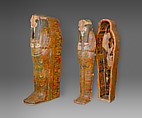Outer Coffin of Djedmutesankh
Third Intermediate Period
The Priestess of Amun, Djedmutesankh, was buried with a number of other members of her wealthy extended family in a tomb on the West Bank at Thebes. Her coffins were found in the main burial chamber, between the coffins of Henettawy, daughter of Painedjem, and Henettawy, daughter of Isetemkheb.
Djedmutesankh's outer coffin, designed to ensure her successful transition from death to eternal life, was covered with linen and paste, painted in reds, greens, and blues on a pale yellow background, and then covered with varnish that has darkened over time. The face, fillet, earrings, breasts, and hands were gilded, as befit her status and wealth; these elements were chopped off in antiquity by thieves. Exhibiting a somewhat crude style thought to date toward the end of the dynasty, the decoration on the lid consists of repetitive motifs, including solar falcons; scarab beetles (symbols of regeneration); seated figures of the funerary god Osiris; and tjet knots, representing the goddess Isis (sister-wife and protector of Osiris). Offering prayers over the legs provide Djedmutesankh's name and titles.
On the sides of the base are images of the deceased and various funerary gods, along with scenes that show the solar barque traveling through the day and night skies. The interior of the base was decorated with a large djed pillar wearing a tall crown with feathers, perhaps representing Osiris, surrounded by various Netherworld deities.
Djedmutesankh's exalted position is reflected by her titles, which include "First Great Chief of the Khener (Musical Troupe) of Amun." This title, which indicates that she was the head of the female priesthood of the great god Amun, suggests that she was a daughter or wife of a High Priest of Amun. During Dynasty 21, the High Priests of Amun controlled the Theban region, so she would have been one of the highest-ranking woman in the area during her lifetime. She bore a number of other important titles as well, although it is interesting to note that she does not include the title "Lady of the House," thought to designate a married woman in charge of a household, on her burial equipment.
Her burial assemblage includes this painted coffin, which contained an inner coffin and a mummy board; an Osiris shroud; leather braces; amulets; viscera figures; two funerary papyri; an Osiris figure; two wooden shabti boxes, and several hundred shabti figures. A heart scarab (see 25.3.162) and a metal falcon amulet (see 25.3.160) had been placed on her chest, but these were stolen in antiquity.
Due to rights restrictions, this image cannot be enlarged, viewed at full screen, or downloaded.
This artwork is meant to be viewed from right to left. Scroll left to view more.




